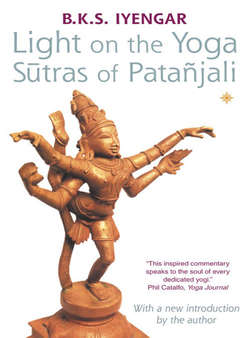Читать книгу Light on the Yoga Sutras of Patanjali - Литагент HarperCollins USD - Страница 37
Pranayama and its effects
ОглавлениеPatañjali states that there must be a progression from Asana to pranayama, but does not mention such a progression in the other branches of yoga. He states that pranayama, should be attempted only after perfection is attained in Asana. This does not mean one Asana alone, as is sometimes suggested.
It should be understood why one Asana is not a sufficient basis for the study of pranayama. In pranayama, the spine and the spinal muscles are the sources of action and the lungs are the receiving instruments. They must be trained to open and to extend backwards, forwards, upwards and outwards, and the spinal muscles straightened, cultured and toned to create space and stimulate the spinal nerves to draw energy from the breath. Inverted postures, forward bends, backbends – the whole range of postures – are therefore essential if we are to derive from pranayama the maximum benefit with the minimum strain.
Normal breath flows irregularly, depending on one’s environment and emotional state. In the beginning, this irregular flow of breath is controlled by a deliberate process. This control creates ease in the inflow and outflow of the breath. When this ease is attained, the breath must be regulated with attention. This is pranayama.
Prana means life force and ayama means ascension, expansion and extension. Pranyama is the expansion of the life force through control of the breath. In modern terms, Prana is equated to bio-energy and works as follows. According to samkhya and yoga philosophies, man is composed of the five elements: earth, water, fire, air and ether. The spine is an element of earth and acts as the field for respiration. Distribution and creation of space in the torso is the function of ether. Respiration represents the element of air. The remaining elements, water and fire, are by nature opposed to one another. The practice of pranayama fuses them to produce energy. This energy is called Prana: life force or bio-energy.
Ayama means extension, vertical ascension, as well as horizontal expansion and circumferential expansion of the breath, lungs and ribcage.
Pranyama by nature has three components: inhalation, exhalation and retention. They are carefully learned by elongating the breath and prolonging the time of retention according to the elasticity of the torso, the length and depth of breath and the precision of movements. This pranayama is known as deliberate or sahita pranayama as one must practise it consciously and continuously in order to learn its rhythm.
To inhalation, exhalation and retention, Patañjali adds one more type of pranayama, that is free from deliberate action. This pranayama, being natural and non-deliberate, transcends the sphere of breath which is modulated by mental volition. It is called kevala kumbhaka or kevala pranayama.
The practice of pranayama removes the veil of ignorance covering the light of intelligence and makes the mind a fit instrument to embark on meditation for the vision of the soul. This is the spiritual quest.
(For further details see Light on Yoga, The Art of Yoga and Light on pranayama (HarperCollinsPublishers) and The Tree of Yoga (Fine Line Books).
